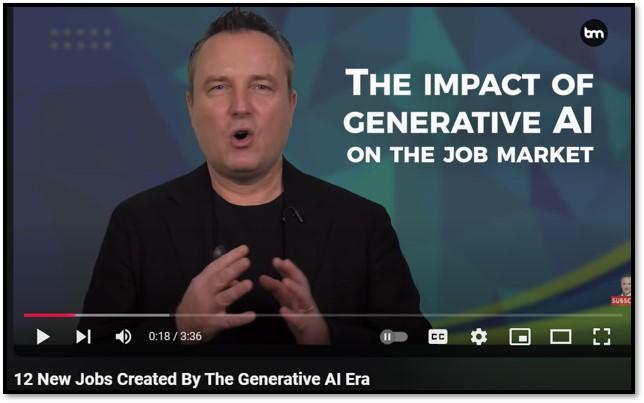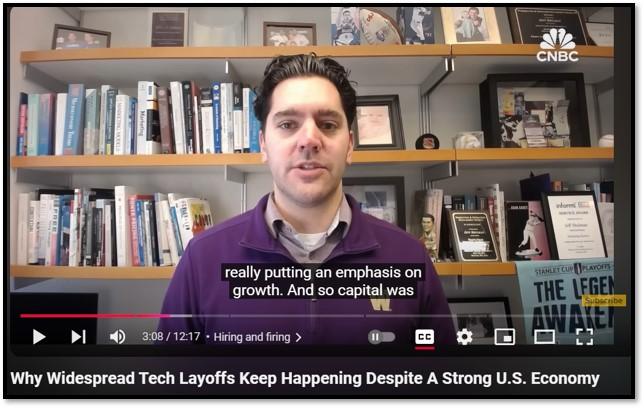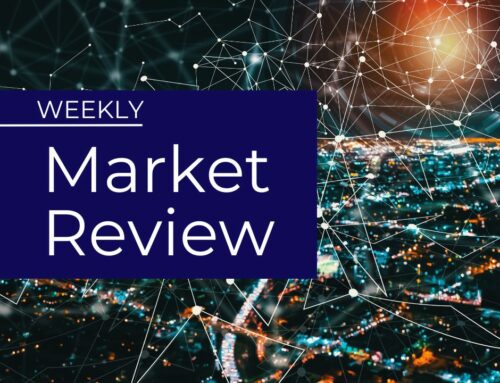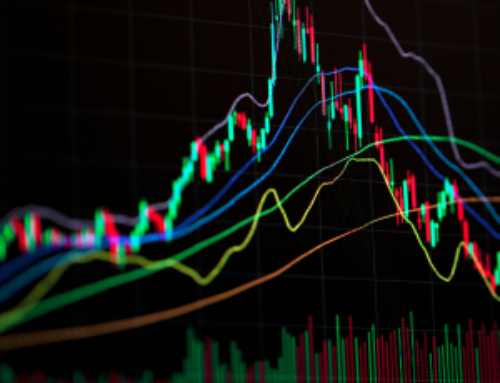

- 1. Recent U.S. economic data has been more positive than expected. In September 2024, the U.S. economy added 254,000 jobs, significantly exceeding predictions.
- 2. Are you getting nervous about a possible stock market decline post US Presidential Elections?
- With the current macro-economic backdrop, below are areas we currently favor:
- 3. Technological advancements and innovations are driving job creation in the U.S., helping to offset the layoffs occurring in various industries.
- 4. World Watch
- 5. Quant & Technical Corner
1. Recent U.S. economic data has been more positive than expected. In September 2024, the U.S. economy added 254,000 jobs, significantly exceeding predictions.
This strong job growth suggests that the economy is resilient despite concerns about a slowdown. The unemployment rate fell to 4.1%, and wages grew at an annual rate of 4%, helping to support consumer spending. As a result, the Federal Reserve is expected to cut interest rates slightly in the coming months to further stabilize the economy. Additionally, U.S. economic growth for 2024 is projected to be around 2.3%, a slightly higher figure than earlier forecasts, reflecting upward revisions in personal income data. This suggests that consumer spending is more sustainable than previously thought, helping the economy maintain solid growth. Overall, the U.S. economy remains on stable footing, with signs of resilience in job creation and consumer activity, even as inflation continues to decline and interest rates adjust. REF: US Dept of Commerce
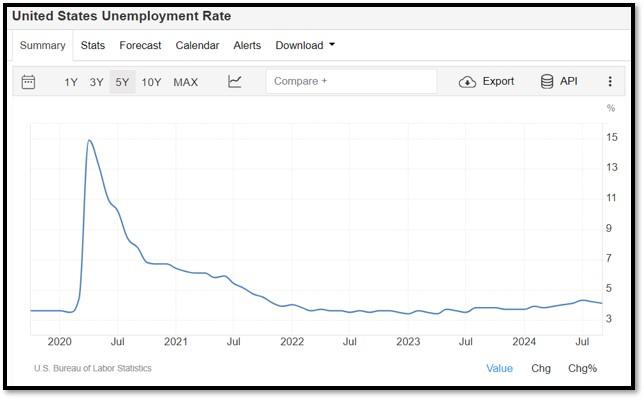
2. Are you getting nervous about a possible stock market decline post US Presidential Elections?
You are not alone. As the 2024 U.S. presidential election approaches, many investors are expressing nervousness about potential market declines. Historically, elections bring volatility to the stock market, and the upcoming contest is expected to be no different. Investors are concerned about the uncertainty surrounding the election outcome, as well as its potential impact on fiscal policies, taxation, and regulations.
Dating back to John F. Kennedy’s inauguration in 1961, the S&P 500 posted a negative return during only two presidencies: Richard Nixon and George W. Bush. The S&P 500 has consistently grown in value over the long-term, no matter who’s in office. Investors should maintain a diversified portfolio, which helps mitigate risks and protect against short-term swings. It’s also important to remind them that panic selling during election periods often leads to missed opportunities, as markets tend to recover. Sticking to a long-term strategy is key to navigating uncertain times. REF: ElectionGuide
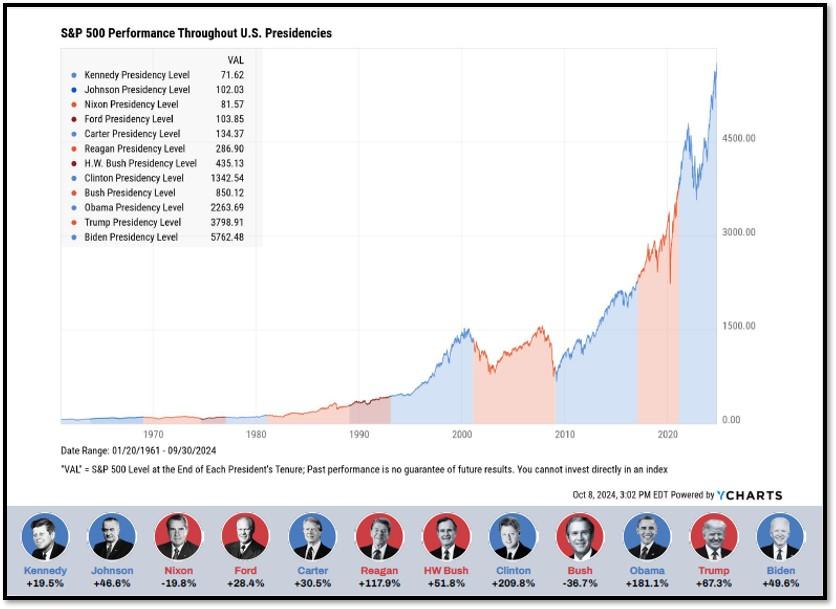
With the current macro-economic backdrop, below are areas we currently favor:
- Fixed Income – Short-term (Low-Beta)
- Fixed Income – Adding Duration, preferred stocks & High Yield as Opportunistic Allocation (Low-Beta)
- Businesses that contribute to and benefit from AI & Automation (Market-Risk)
- Mid Cap Stocks & Small Cap Stocks
- Clean Energy / Solar / Utilities (Market-Risk)
- Healthcare & Biotechnology (Market-Risk)
- Gold (Market-Risk)
- Industrials (Market-Risk)
3. Technological advancements and innovations are driving job creation in the U.S., helping to offset the layoffs occurring in various industries.
While many firms, especially in sectors like tech, have experienced consistent layoffs due to restructuring or economic shifts, new developments in fields such as artificial intelligence (AI), renewable energy, and biotechnology are generating a significant number of new jobs. Emerging industries like green energy are seeing rapid growth, with the expansion of solar, wind, and electric vehicle production creating jobs in manufacturing, engineering, and logistics. Similarly, the rise of AI and automation, while contributing to some job displacement, is also leading to new roles in data science, machine learning, and AI ethics, as companies seek skilled workers to develop and manage these technologies.
Moreover, the push for digital transformation across sectors, including healthcare and education, has spurred demand for software developers, cybersecurity experts, and tech consultants. These areas are seeing a surge in employment opportunities, particularly as businesses and institutions adapt to evolving technological needs. In essence, while layoffs in traditional sectors remain a concern, innovations in technology are helping to balance the labor market by creating new job opportunities that align with the digital economy and sustainable development. Click onto pictures below to access videos. REF: EPI, Booth School of Business, BLS
4. World Watch
4A. China, facing economic stagnation and heightened tensions with regional powers like India, Australia, and the Philippines, is working to rebuild its foreign relations. Economic issues, including declining growth and a troubled real estate sector, are compounded by unresolved border disputes with India, strained trade ties with Australia, and conflicts over the South China Sea with Southeast Asian nations.
To address these challenges, China is rebranding its Belt and Road Initiative (BRI) as a cooperative venture, engaging in economic diplomacy to improve trade relations, and participating more actively in multilateral forums like BRICS and ASEAN. It is also using soft power, such as cultural exchanges, to enhance its global image. Efforts to de-escalate tensions in the South China Sea through dialogue and resource-sharing agreements further reflect its desire to stabilize regional relations. China’s focus on restoring foreign relations is crucial for mitigating its economic slowdown and maintaining global influence. The success of these initiatives will shape its future as a global power. Click onto picture below to access video. REF: WSJ
4B. BYD, a Chinese electric vehicle (EV) manufacturer, is leading the race to build cheaper EVs by leveraging its expertise in battery technology and vertical integration. Unlike many competitors, BYD produces its own batteries, significantly reducing production costs. This allows the company to offer more affordable vehicles while maintaining quality. Key to BYD’s success is its innovative Blade Battery, a safer and more efficient lithium-iron-phosphate (LFP) battery that lowers costs without sacrificing performance. This has helped BYD expand in price-sensitive markets and internationally, positioning it as a strong competitor to major automakers like Tesla. BYD’s focus on cost efficiency and innovation is driving its success in making EVs more accessible, reshaping the global market for electric vehicles.
BYD executives say the company is just trying to sell cars and fight climate change. But it also wants to do what no Chinese carmaker has ever done: become a globally recognized consumer brand. It’s hoping to transcend geopolitics through the appeal of a plug-in hybrid sedan that can go 1,200 miles without stopping at a pump or a charger. Stella Li, BYD’s executive vice president and the face of its global expansion, says she wants consumers to see BYD as “a technological pioneer in changing the world.” Click onto picture below to access Podcast/video. REF: Bloomberg
4C. The European Central Bank (ECB) has cut interest rates again in response to inflation in the Eurozone falling below the 2% target. This move is part of the ECB’s ongoing effort to stimulate economic growth and prevent deflation in the region. With inflation now below the ECB’s target, there is less pressure on prices, signaling weaker demand and slower economic activity. Lowering interest rates aims to make borrowing cheaper for businesses and consumers, encouraging investment and spending to boost economic growth. By cutting rates, the ECB hopes to revive consumption, drive up inflation to its target, and support the overall recovery of the Eurozone economy.
The rate cut is expected to increase liquidity in the financial system, lower borrowing costs, and stimulate economic activity. However, it also highlights concerns about slower growth and underlying economic weaknesses in the region. The ECB’s focus now is to balance encouraging growth while ensuring inflation doesn’t fall too far below target. Click onto picture below to access video. REF: BARRON’S
4D. Below is an updated snapshot of the current global state of economy according to TradingEconomics as of 10/23/2024. REF: TradingEconomics
- The Chinese economy grew by a seasonally adjusted 0.9% in Q3 of 2024, after a 0.7% increase in Q2. It was the ninth straight period of quarterly rise, supported by recent government initiatives aimed at stimulating consumption, mitigating deflation risks, and reversing the downturn in the real estate sector.
- The People’s Bank of China slashed key lending rates to new lows at the October fixing, intensifying efforts to support a weakening economy.
- China’s surveyed unemployment rate fell to 5.1% in September 2024, compared to market estimates and August’s reading of 5.3%.
- The benchmark interest rate in Germany is set by the European Central Bank. Interest Rate in Germany averaged 1.85 percent from 1998 until 2024, reaching an all time high of 4.75 percent in October of 2000 and a record low of 0.00 percent in March of 2016.
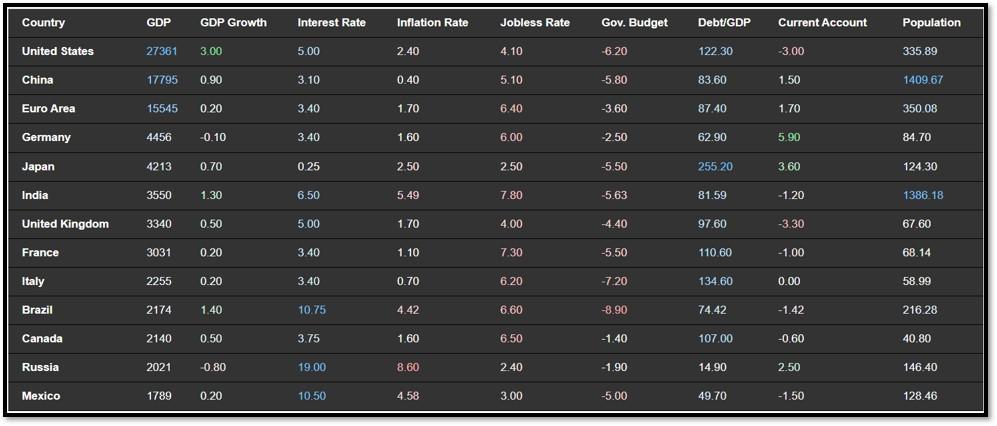
5. Quant & Technical Corner
Below is a selection of quantitative & technical data we monitor on a regular basis to help gauge the overall financial market conditions and the investment environment.
5A. Most recent read on the Fear & Greed Index with data as of 10/22/2024 – 7:59AM-ET is 70 (Greed). Last week’s data was 66 (Greed) (1-100). CNNMoney’s Fear & Greed index looks at 7 indicators (Stock Price Momentum, Stock Price Strength, Stock Price Breadth, Put and Call Options, Junk Bond Demand, Market Volatility, and Safe Haven Demand). Keep in mind this is a contrarian indicator! REF: Fear&Greed via CNNMoney
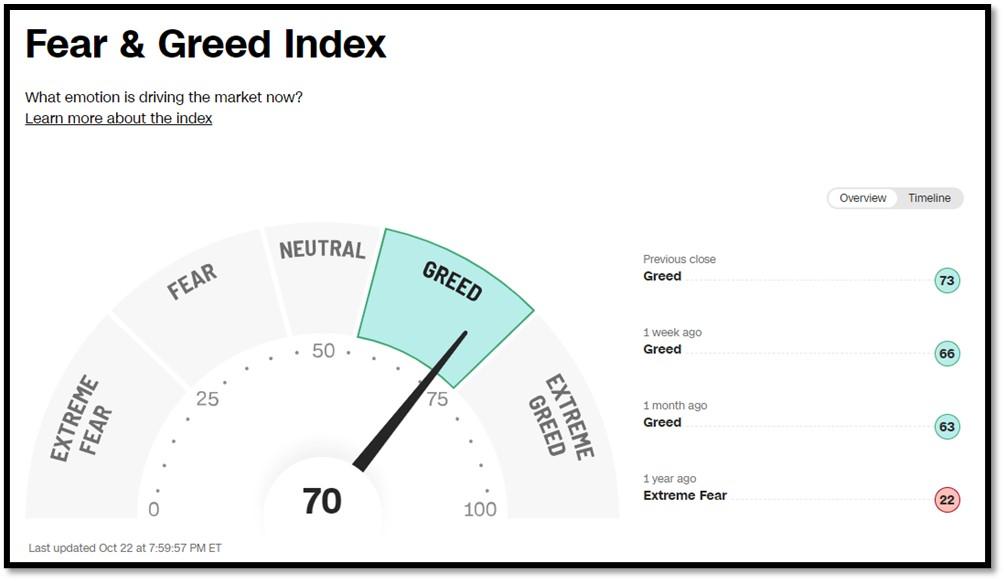
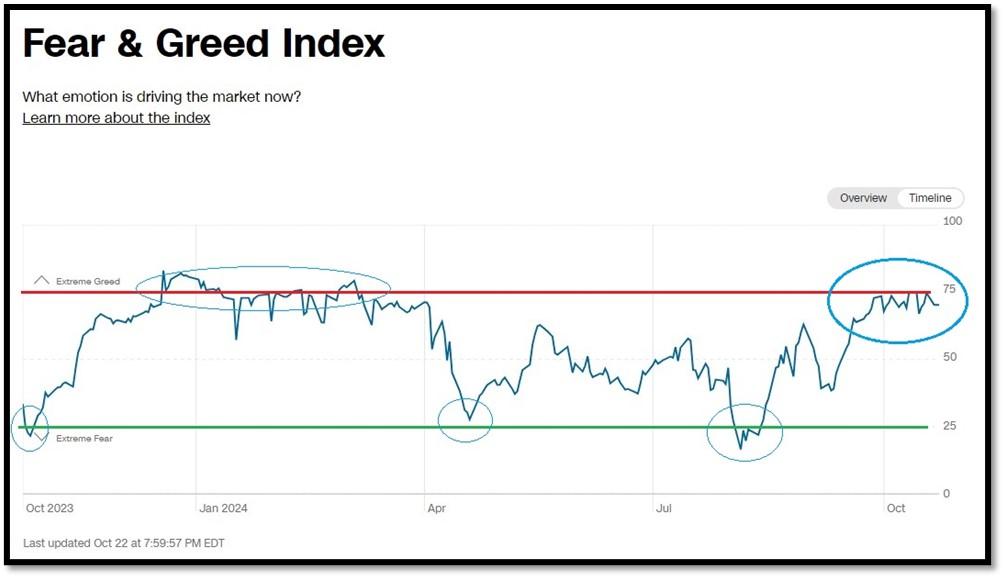
5B. St. Louis Fed Financial Stress Index’s (STLFSI4) most recent read is at –0.6079 as of October 17, 2024. A big spike up from previous readings reflecting the recent turmoil in the banking sector. Previous week’s data was -0.6174. This weekly index is not seasonally adjusted. The STLFSI4 measures the degree of financial stress in the markets and is constructed from 18 weekly data series: seven interest rate series, six yield spreads and five other indicators. Each of these variables captures some aspect of financial stress. Accordingly, as the level of financial stress in the economy changes, the data series are likely to move together. REF: St. Louis Fed

5C. University of Michigan, University of Michigan: Consumer Sentiment for June [UMCSENT] at 67.9 (last month’s data at 66.4), retrieved from FRED, Federal Reserve Bank of St. Louis, September 27, 2024. Back in June 2022, Consumer Sentiment hit a low point going back to April 1980. REF: UofM
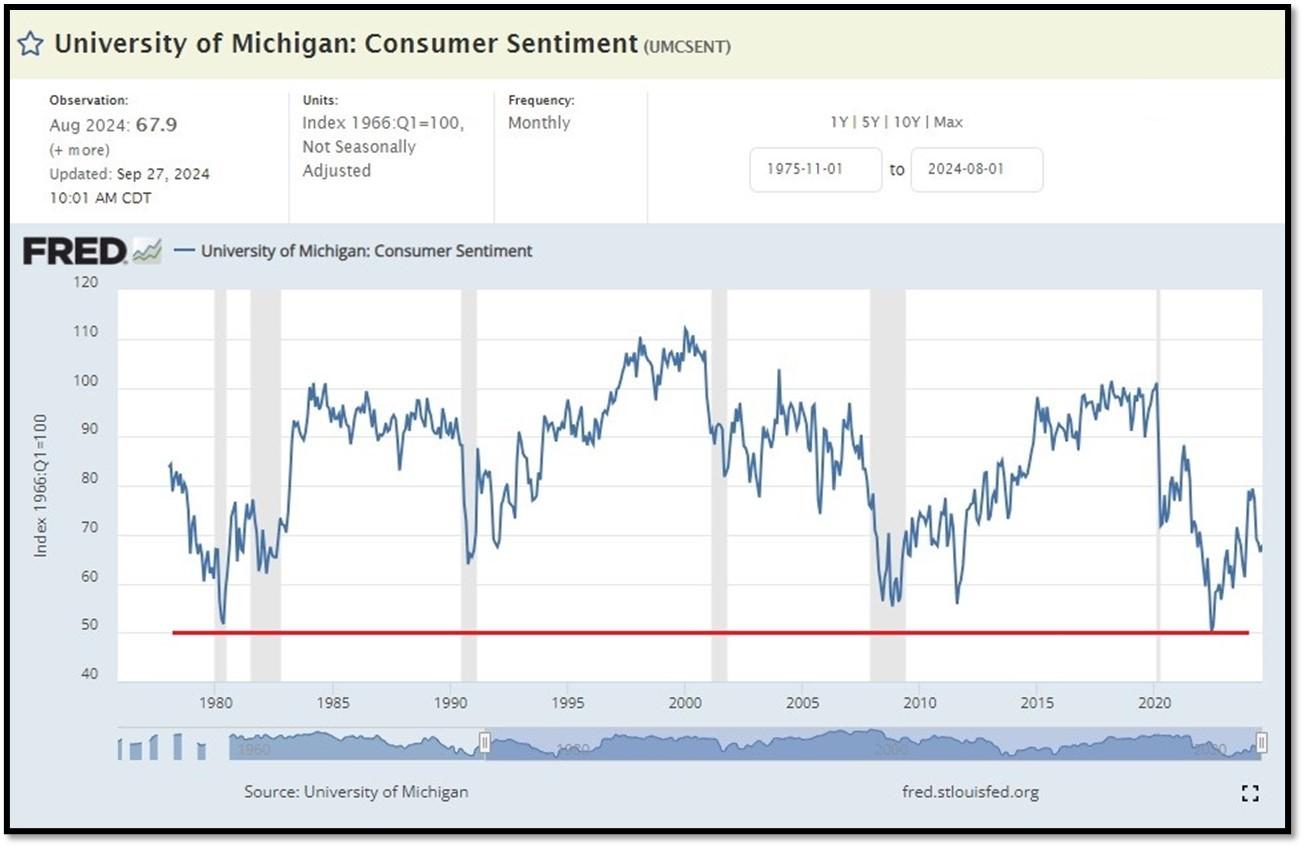
5D. The Chicago Fed National Activity Index (CFNAI) increased to +0.12 in August from –0.42 in July. Two of the four broad categories of indicators used to construct the index increased from July, and one category made a positive contribution in August. The index’s three-month moving average, CFNAI-MA3, decreased to –0.17 in August from –0.13 in July. REF: ChicagoFed, August’s Report
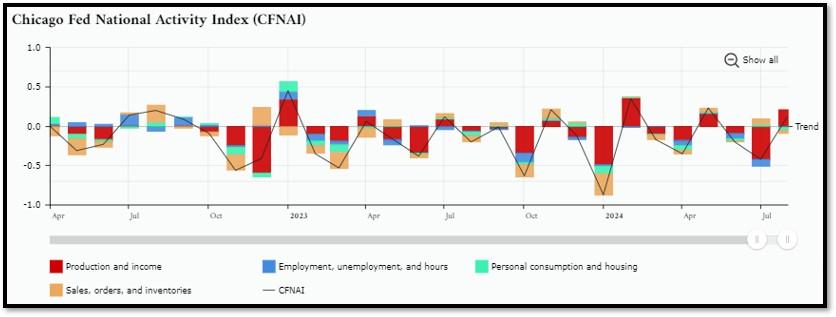
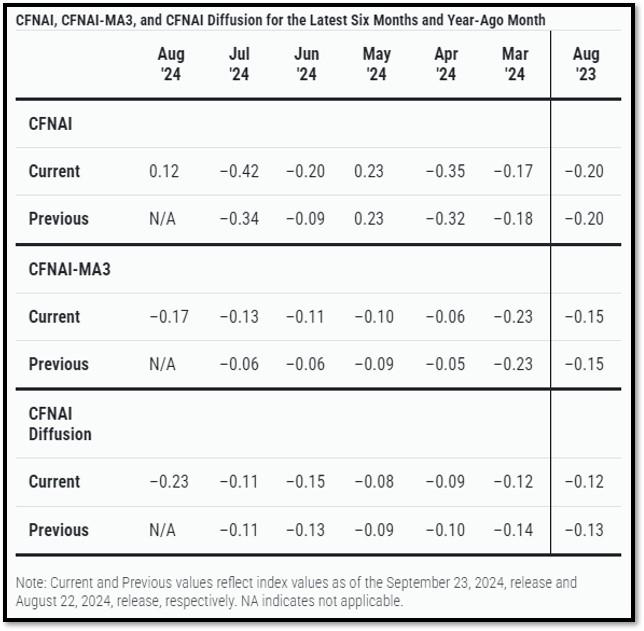
5E. (10/21/2024) The Conference Board Leading Economic Index (LEI) for the US declined by 0.5% in September 2024 to 99.7 (2016=100), following a 0.3% decline in August. Over the six-month period between March and September 2024, the LEI fell by 2.6%, more than its 2.2% decline over the previous six-month period (September 2023 to March 2024). The composite economic indexes are the key elements in an analytic system designed to signal peaks and troughs in the business cycle. The indexes are constructed to summarize and reveal common turning points in the economy in a clearer and more convincing manner than any individual component. The CEI is highly correlated with real GDP. The LEI is a predictive variable that anticipates (or “leads”) turning points in the business cycle by around 7 months. Shaded areas denote recession periods or economic contractions. The dates above the shaded areas show the chronology of peaks and troughs in the business cycle. The ten components of The Conference Board Leading Economic Index® for the U.S. include: Average weekly hours in manufacturing; Average weekly initial claims for unemployment insurance; Manufacturers’ new orders for consumer goods and materials; ISM® Index of New Orders; Manufacturers’ new orders for nondefense capital goods excluding aircraft orders; Building permits for new private housing units; S&P 500® Index of Stock Prices; Leading Credit Index™; Interest rate spread (10-year Treasury bonds less federal funds rate); Average consumer expectations for business conditions. REF: ConferenceBoard, LEI Report for September (Released on 10/21/2024)
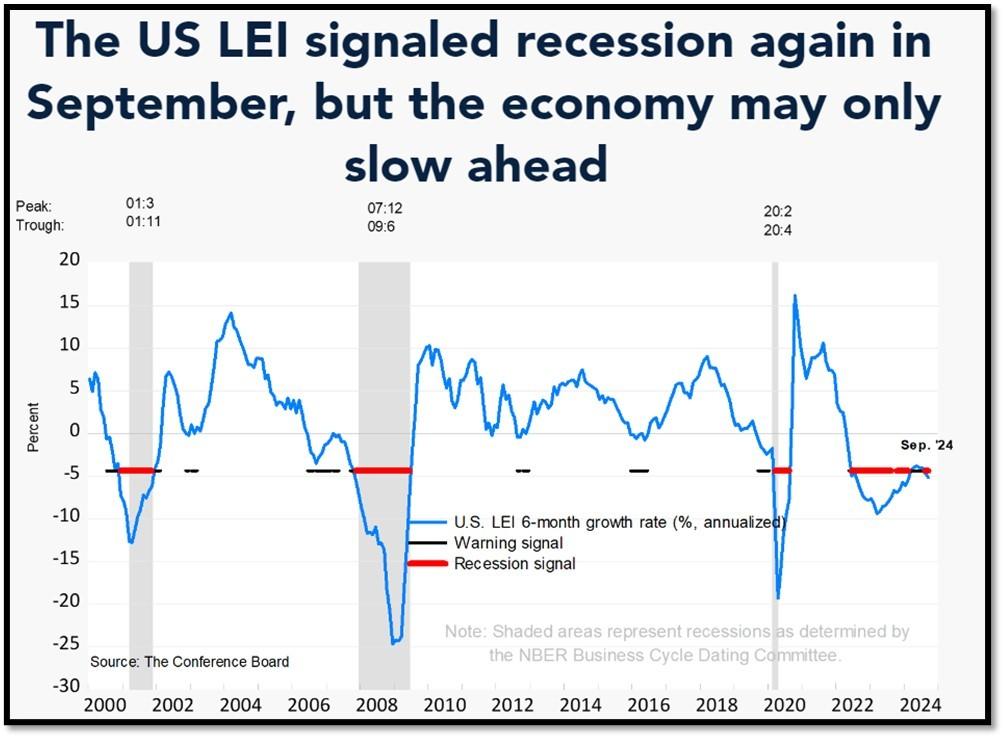
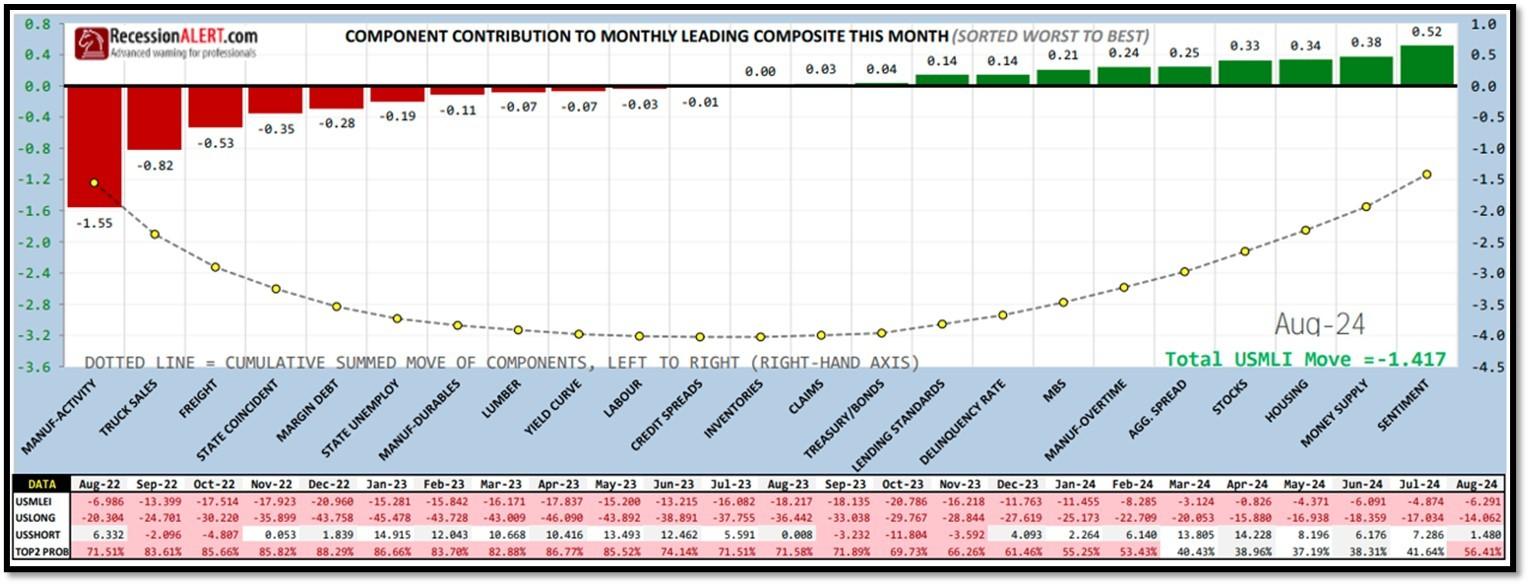
5F. Probability of U.S. falling into Recession within 3 to 4 months is currently at 66.48% (with data as of 10/21/2024 – Next Report 11/4/2024) according to RecessionAlert Research. Last release’s data was at 71.04%. This report is updated every two weeks. REF: RecessionAlertResearch
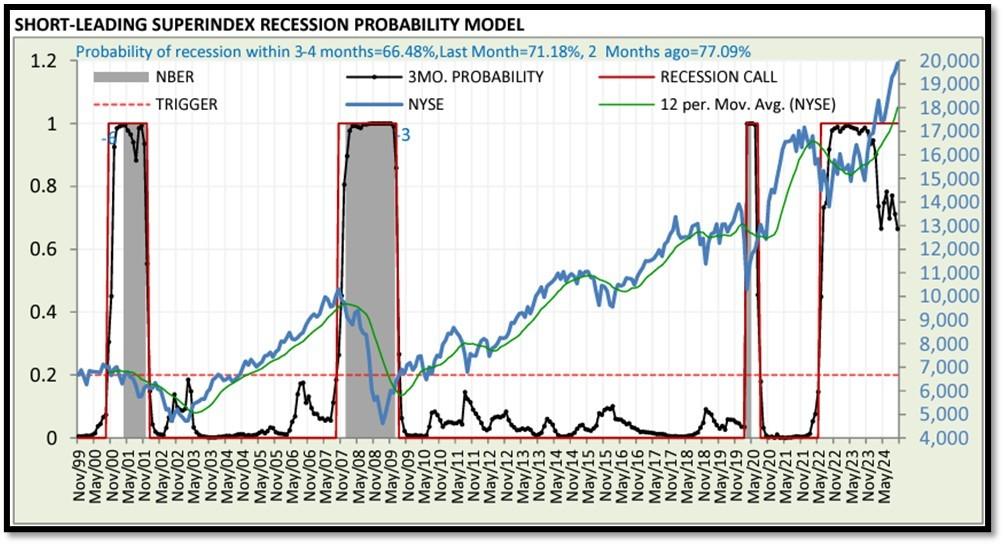
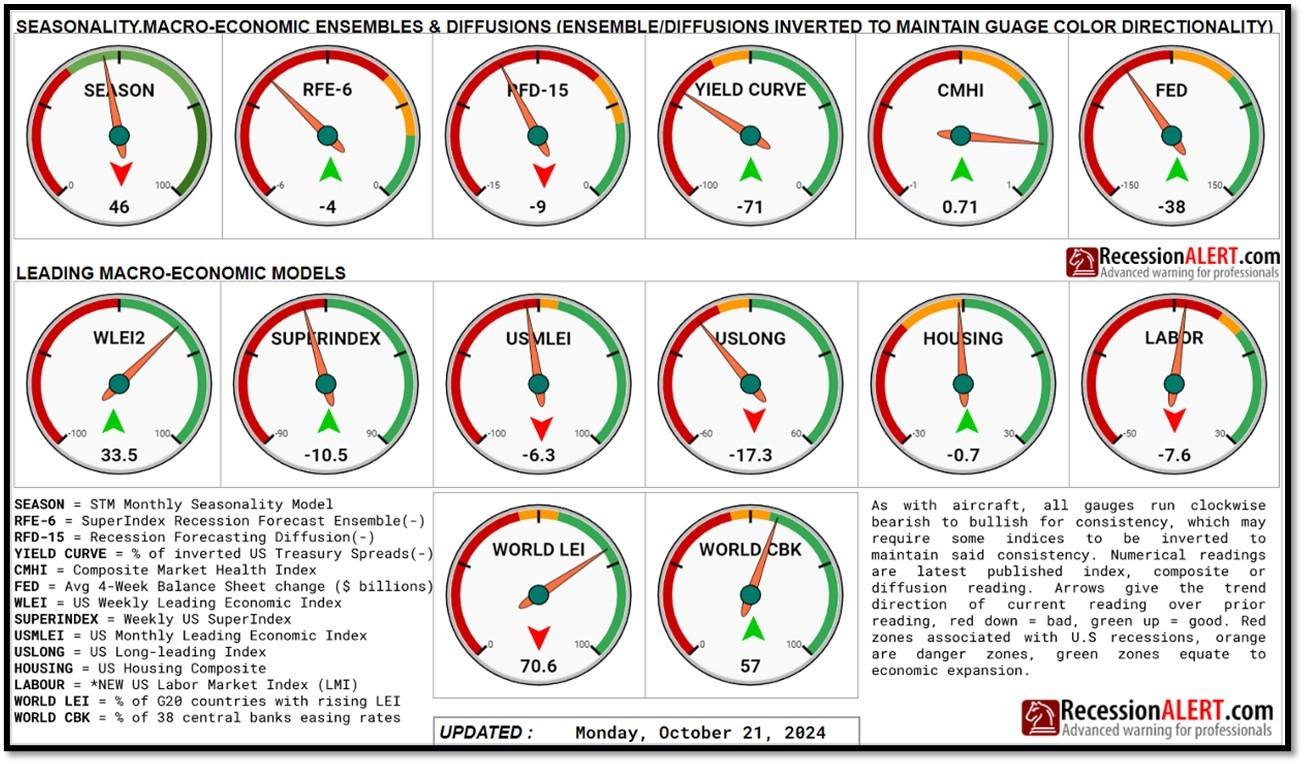
5G. Yield Curve as of 10/22/2024 is showing Inversion to Flattening. Spread on the 10-yr Treasury Yield (4.23%) minus yield on the 2-yr Treasury Yield (4.05%) is currently at 18 bps. REF: Stockcharts The yield curve—specifically, the spread between the interest rates on the ten-year Treasury note and the three-month Treasury bill—is a valuable forecasting tool. It is simple to use and significantly outperforms other financial and macroeconomic indicators in predicting recessions two to six quarters ahead. REF: NYFED

5H. Recent Yields in 10-Year Government Bonds. REF: Source is from Bloomberg.com, dated 10/22/2024, rates shown below are as of 10/22/2024, subject to change.
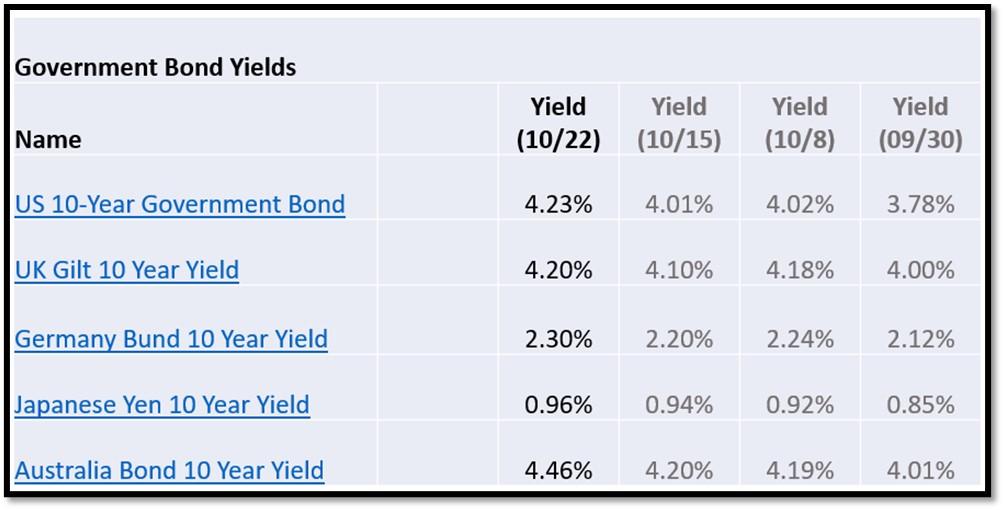
The 10-Year US Treasury Yield… REF: StockCharts1, StockCharts2
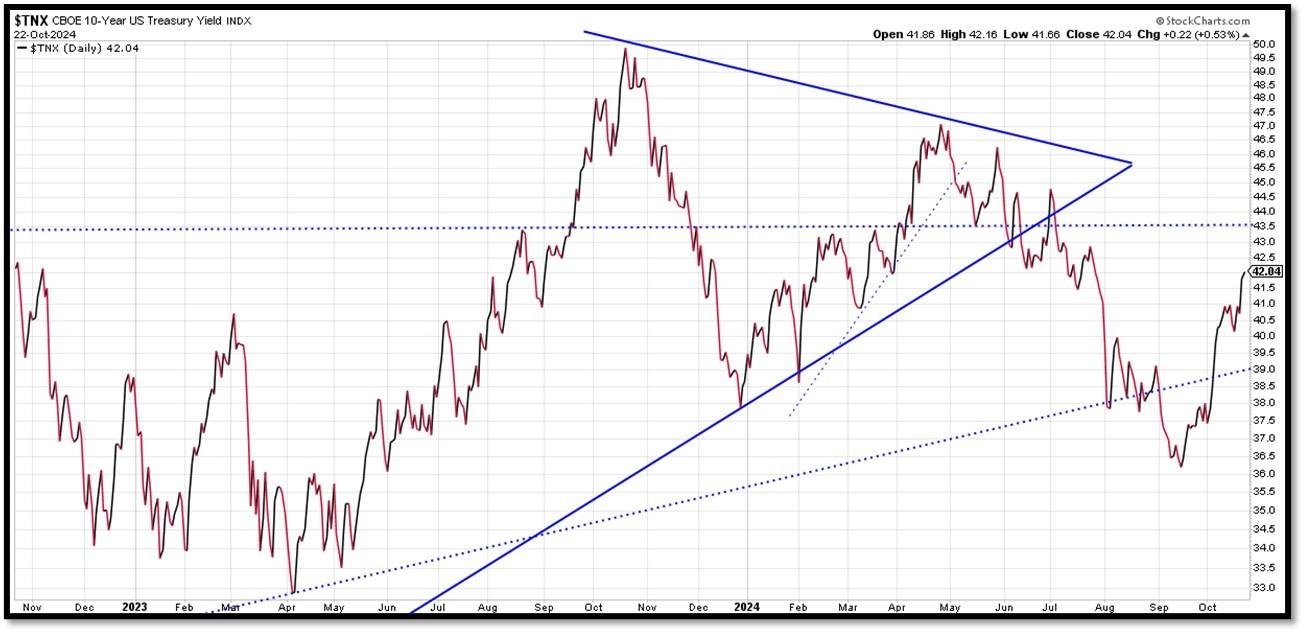
The 10-year yield – Spiked towards top of trend…
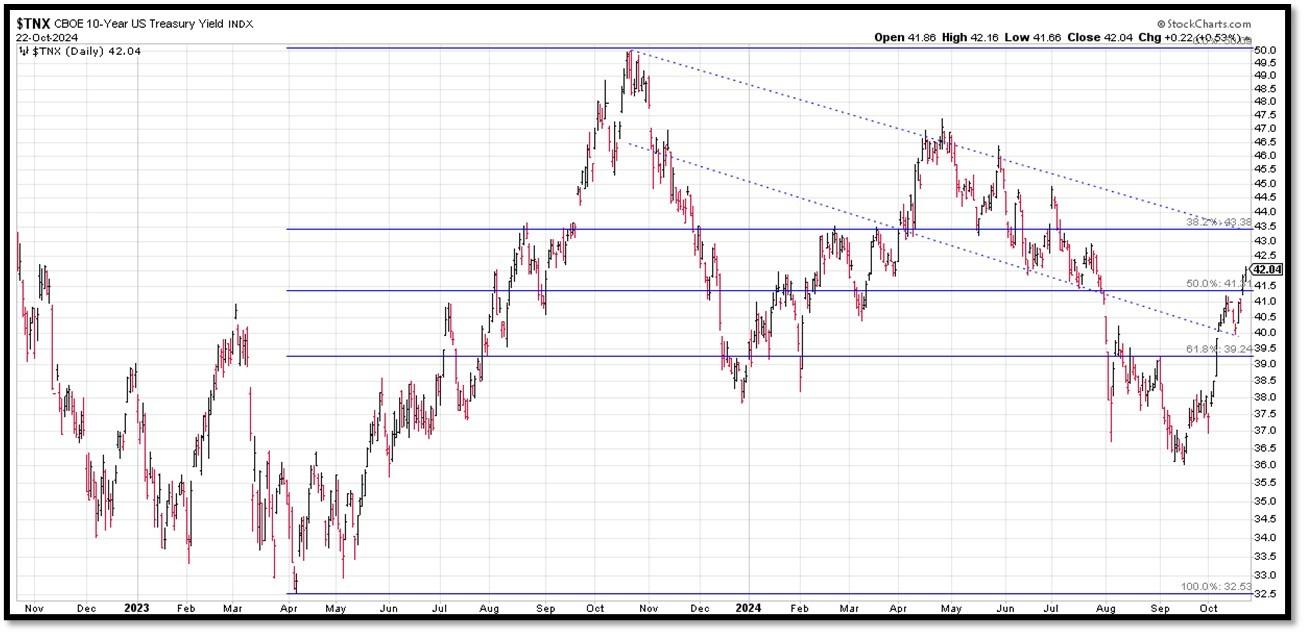
10-Year Real Interest Rate at 1.5016% as of 10/10/24. REF: REAINTRATREARAT10Y

Federal government Interest Payments increased $22B to $1.096 T as of Q2-2024. REF: FRED-A091RC1Q027SBEA
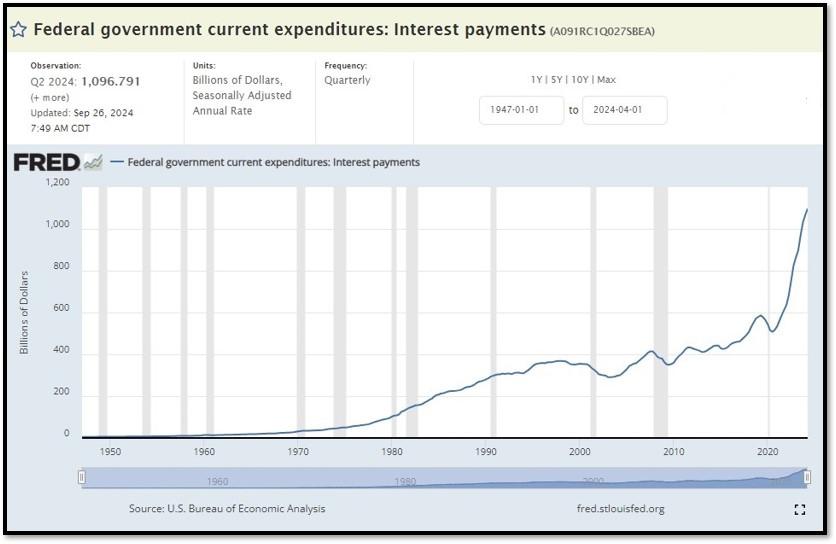
Interest payments as a percentage of GDP increased from 1.84853 in 2022 to 2.37794 as of 10/18/24. REF: FRED-FYOIGDA188S
5I. (10/22/2024) Today’s National Average 30-Year Fixed Mortgage Rate is 6.85% (All Time High was 8.03% on 10/19/23). Last week’s data was 6.62%. This rate is the average 30-year fixed mortgage rates from several different surveys including Mortgage News Daily (daily index), Freddie Mac (weekly survey), Mortgage Bankers Association (weekly survey) and FHFA (monthly survey). REF: MortgageNewsDaily, Today’s Average Rate
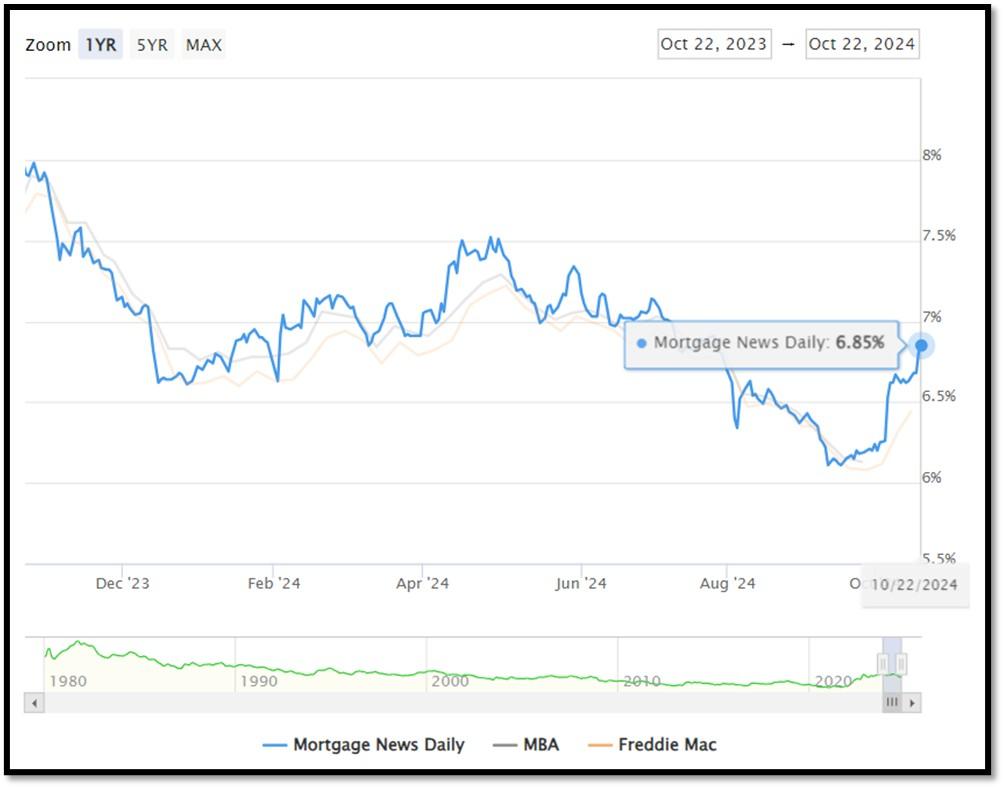
(10/15/24) Housing Affordability Index for Aug = 98.6 // July = 95 // June = 93.3 // May = 93.1 // April = 95.9 // March = 101.1 // February = 103.0. Data provided by Yardeni Research. REF: Yardeni
5J. Velocity of M2 Money Stock (M2V) with current read at 1.385 as of (Q2-2024 updated 9/26/2024). Previous quarter’s data was 1.368. The velocity of money is the frequency at which one unit of currency is used to purchase domestically- produced goods and services within a given time period. In other words, it is the number of times one dollar is spent to buy goods and services per unit of time. If the velocity of money is increasing, then more transactions are occurring between individuals in an economy. Current Money Stock (M2) report can be viewed in the reference link. REF: St.LouisFed-M2V

M2 consists of M1 plus (1) small-denomination time deposits (time deposits in amounts of less than $100,000) less IRA and Keogh balances at depository institutions; and (2) balances in retail MMFs less IRA and Keogh balances at MMFs. Seasonally adjusted M2 is constructed by summing savings deposits (before May 2020), small-denomination time deposits, and retail MMFs, each seasonally adjusted separately, and adding this result to seasonally adjusted M1. Board of Governors of the Federal Reserve System (US), M2 [M2SL], retrieved from FRED, Federal Reserve Bank of St. Louis; Updated on October 22, 2024. REF: St.LouisFed-M2
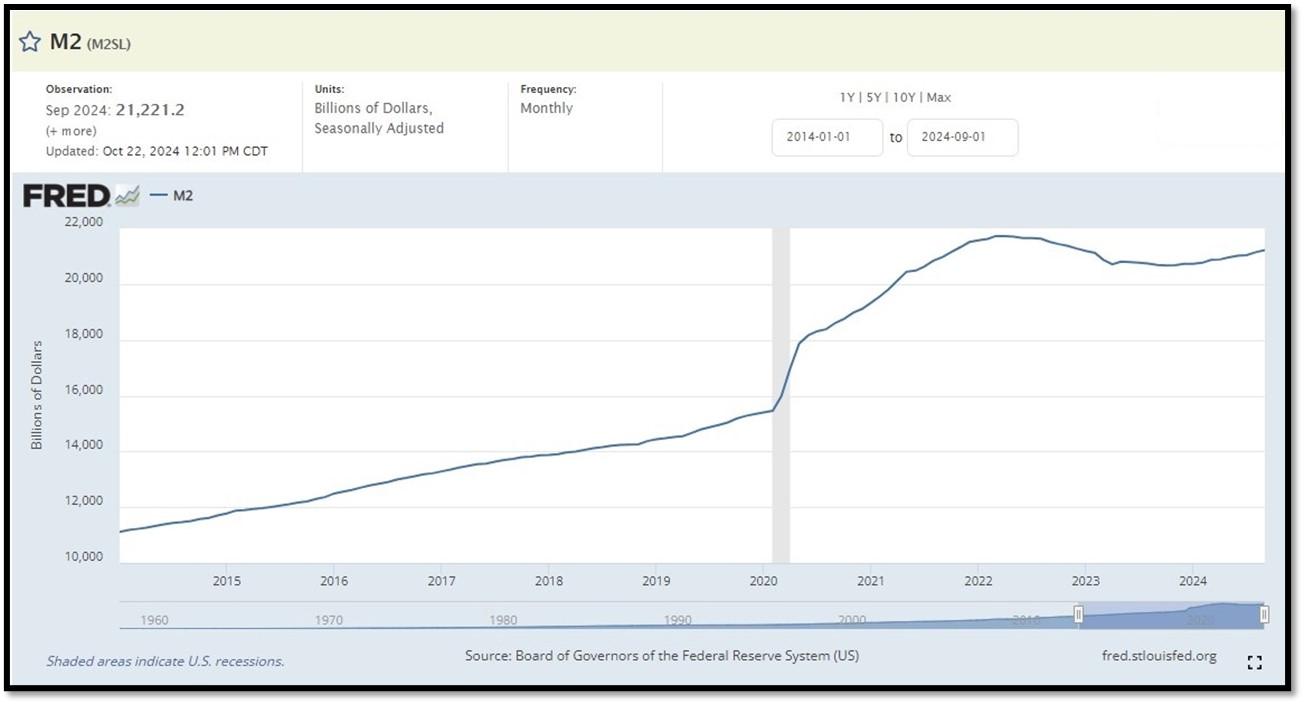
Money Supply M0 in the United States decreased to 5,588,400 USD Million in September from 5,670,200 USD Million in August of 2024. Money Supply M0 in the United States averaged 1,149,440.43 USD Million from 1959 until 2024, reaching an all-time high of 6,413,100.00 USD Million in December of 2021 and a record low of 48,400.00 USD Million in February of 1961. REF: TradingEconomics, M0
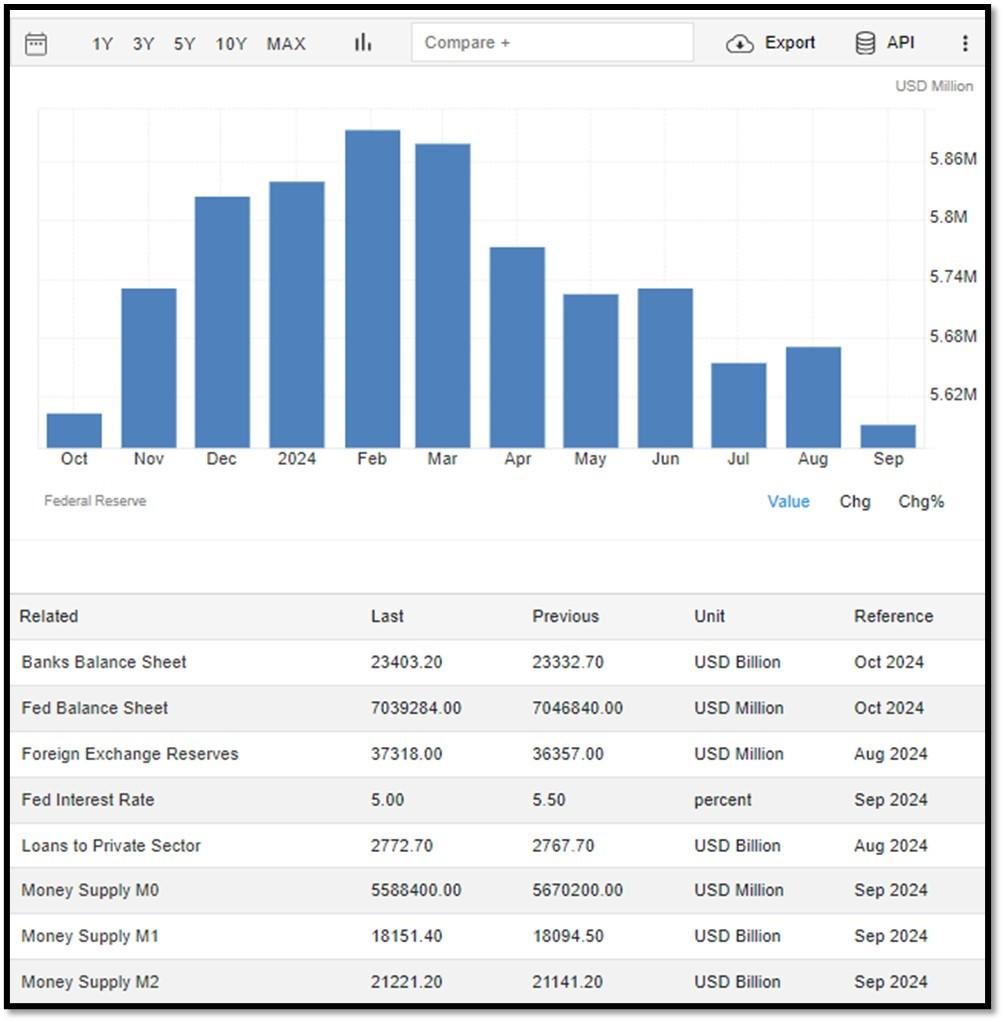
5K. In September, the Consumer Price Index for All Urban Consumers rose 0.2 percent, seasonally adjusted, and rose 2.4 percent over the last 12 months, not seasonally adjusted. The index for all items less food and energy increased 0.3 percent in September (SA); up 3.3 percent over the year (NSA). October 2024 CPI data are scheduled to be released on November 13, 2024, at 8:30AM-ET. REF: BLS, BLS.GOV
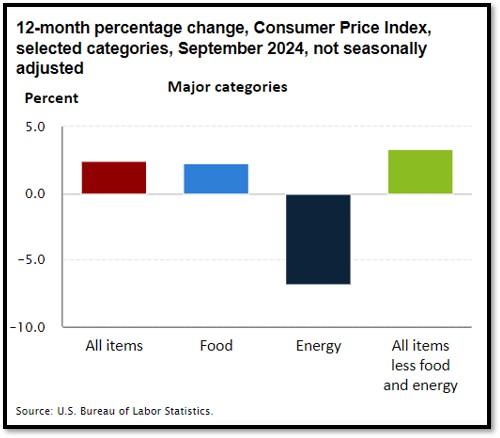
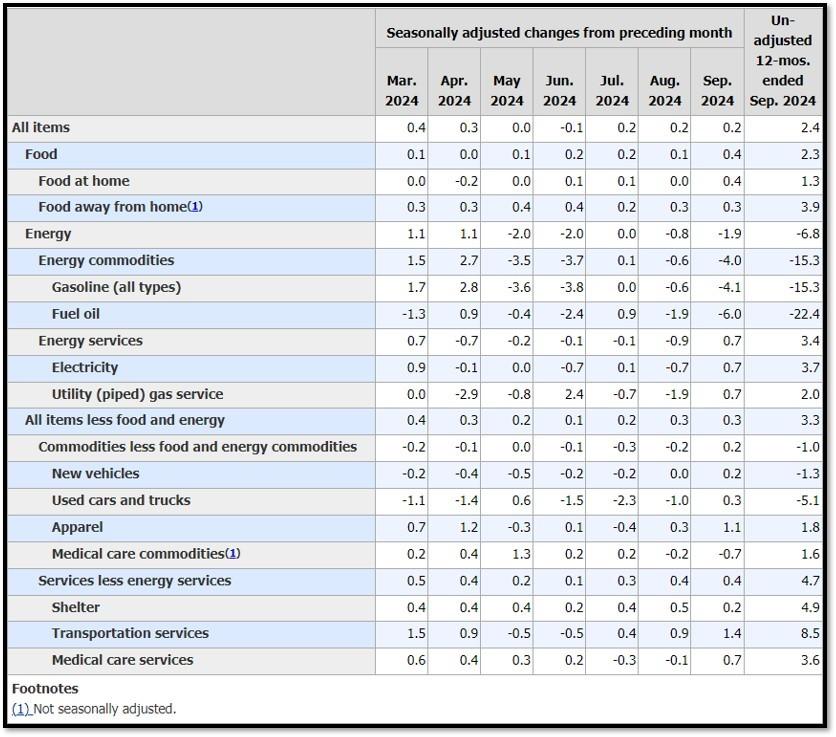
5L. Technical Analysis of the S&P500 Index. Click onto reference links below for images.
- Short-term Chart: Less Bullish on 10/22/2024 – REF: Short-term S&P500 Chart by Marc Slavin (Click Here to Access Chart)
- Medium-term Chart: Bullish on 10/22/2024 – REF: Medium-term S&P500 Chart by Marc Slavin (Click Here to Access Chart)
- Market Timing Indicators – S&P500 Index as of 10/22/2024 – REF: S&P500 Charts (7 of them) by Joanne Klein’s Top 7 (Click Here to Access Updated Charts)
- A well-defined uptrend channel shown in green with S&P500 getting back on trend. REF: Stockcharts
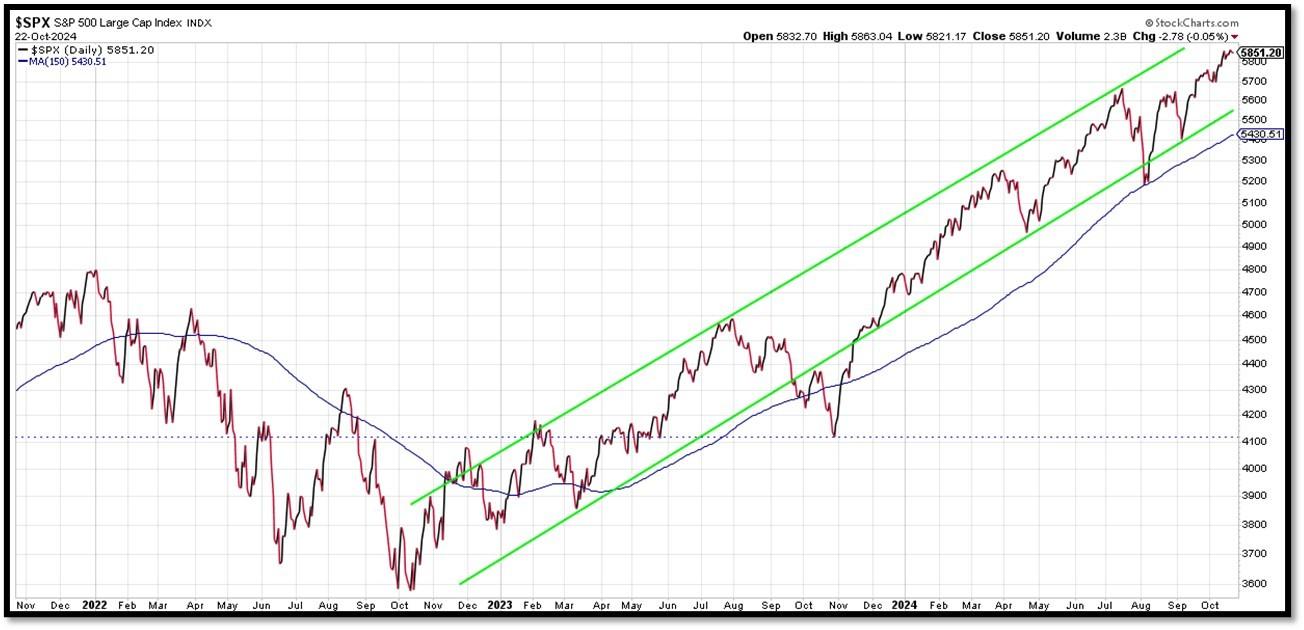
- S&P500 and CBOE Volatility Index (VIX) as of 10/22/2024. REF: FRED, Today’s Print
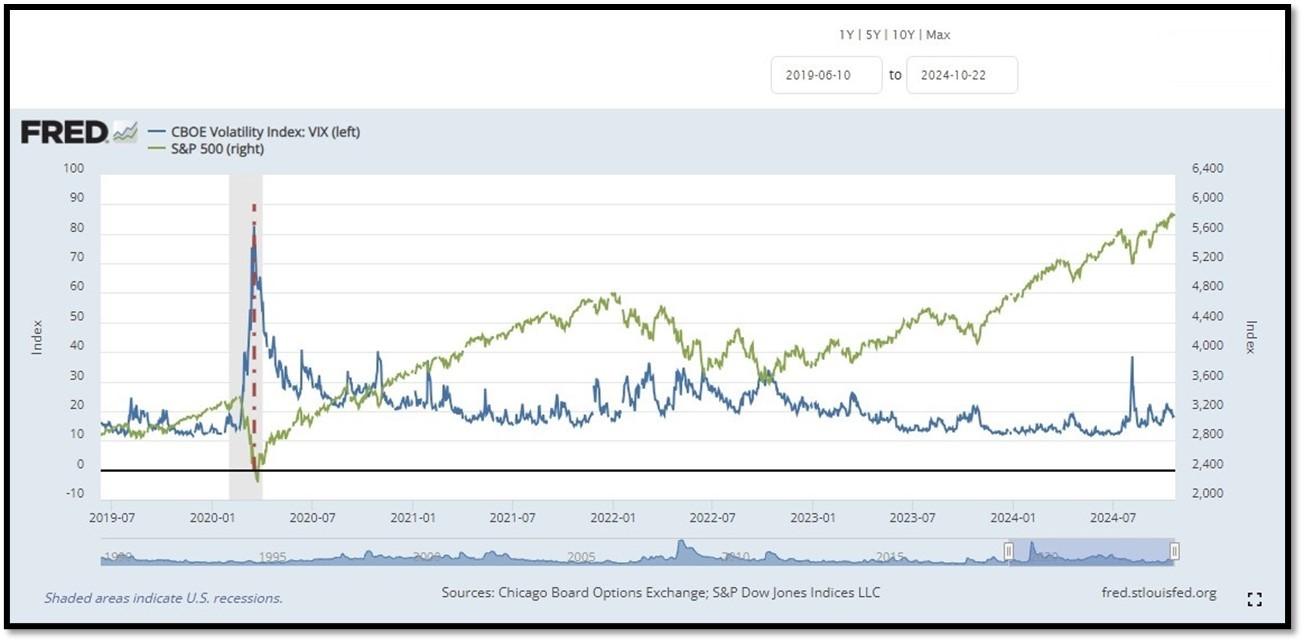
5M. Most recent read on the Crypto Fear & Greed Index with data as of 10/23/2024au is 71 (Neutral). Last week’s data was 73 (Greed) (1-100). Fear & Greed Index – A Contrarian Data. The crypto market behavior is very emotional. People tend to get greedy when the market is rising which results in FOMO (Fear of missing out). Also, people often sell their coins in irrational reaction of seeing red numbers. With the Crypto Fear and Greed Index, the data try to help save investors from their own emotional overreactions. There are two simple assumptions:
- Extreme fear can be a sign that investors are too worried. That could be a buying opportunity.
- When Investors are getting too greedy, that means the market is due for a correction.
Therefore, the program for this index analyzes the current sentiment of the Bitcoin market and crunch the numbers into a simple meter from 0 to 100. Zero means “Extreme Fear”, while 100 means “Extreme Greed”. REF: Alternative.me, Today’sReading
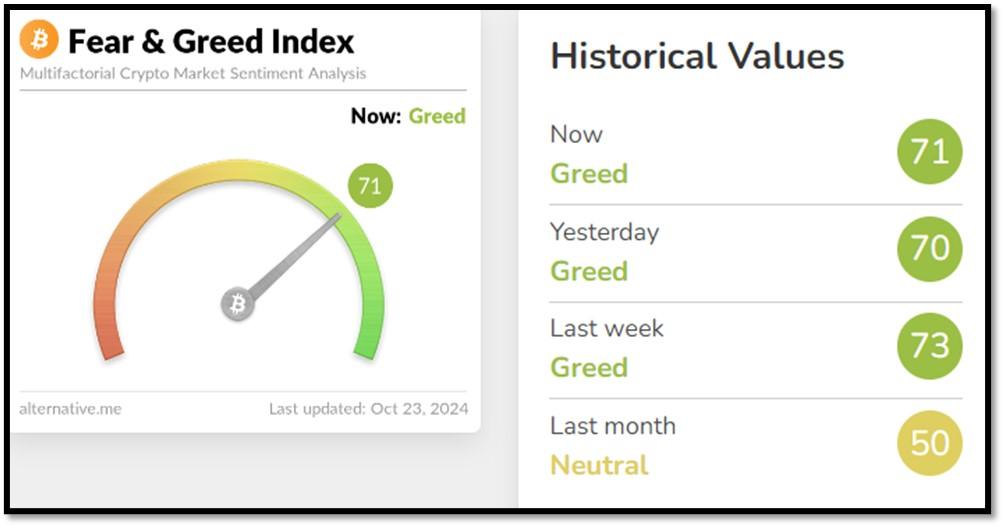

Bitcoin – Could it break out to the upside? REF: Stockcharts
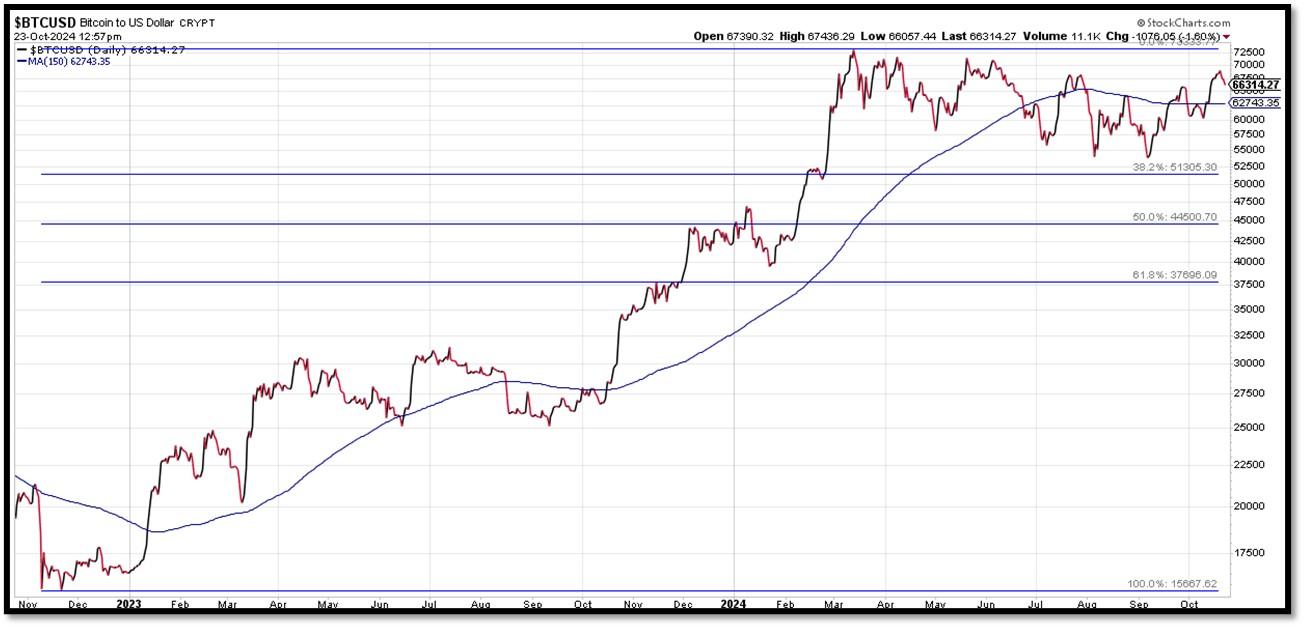
From the desk of our Chief Investment Officer
As an investment professional with over twenty-six years of experience in the financial services industry, Andrew helps clients to protect, grow and transfer wealth during their lifetime with objective, unbiased, customized and efficient strategies.
Education, Professional Licenses Acquired & Affiliations
- Series 7, 63, 65 and 24 Licensed.
- Currently holding Series 65 License registered with SEC
- BA in Economics – Boston University (Boston, MA) 1993
- Certificate in Commodities Trading – New York University (New York, NY) 1991
- Certificate in Financial Planning – New York University (New York, NY) April 2011
With extensive experience in the Financial Services Industry, Andrew Tang and Turner Financial Group provides disciplined wealth management with an intelligent caring approach to each and every client that compliments the Dedicated Financial offering.


Len writes much of his own content, and also shares helpful content from other trusted providers like Turner Financial Group (TFG).
The material contained herein is intended as a general market commentary, solely for informational purposes and is not intended to make an offer or solicitation for the sale or purchase of any securities. Such views are subject to change at any time without notice due to changes in market or economic conditions and may not necessarily come to pass. This information is not intended as a specific offer of investment services by Dedicated Financial and Turner Financial Group, Inc.
Dedicated Financial and Turner Financial Group, Inc., do not provide tax, legal or accounting advice. You should consult your own tax, legal and accounting advisors before engaging in any transaction.
Any hyperlinks in this document that connect to Web Sites maintained by third parties are provided for convenience only. Turner Financial Group, Inc. has not verified the accuracy of any information contained within the links and the provision of such links does not constitute a recommendation or endorsement of the company or the content by Dedicated Financial or Turner Financial Group, Inc. The prices/quotes/statistics referenced herein have been obtained from sources verified to be reliable for their accuracy or completeness and may be subject to change.
Past performance is no guarantee of future returns. Investing involves risk and possible loss of principal capital. The views and strategies described herein may not be suitable for all investors. To the extent referenced herein, real estate, hedge funds, and other private investments can present significant risks, including loss of the original amount invested. All indexes are unmanaged, and an individual cannot invest directly in an index. Index returns do not include fees or expenses.
Turner Financial Group, Inc. is an Investment Adviser registered with the United States Securities and Exchange Commission however, such registration does not imply a certain level of skill or training and no inference to the contrary should be made. Additional information about Turner Financial Group, Inc. is also available at www.adviserinfo.sec.gov. Advisory services are only offered to clients or prospective clients where Turner Financial Group, Inc. and its representatives are properly licensed or exempt from licensure. No advice may be rendered by Turner Financial Group, Inc. unless a client service agreement is in place.


